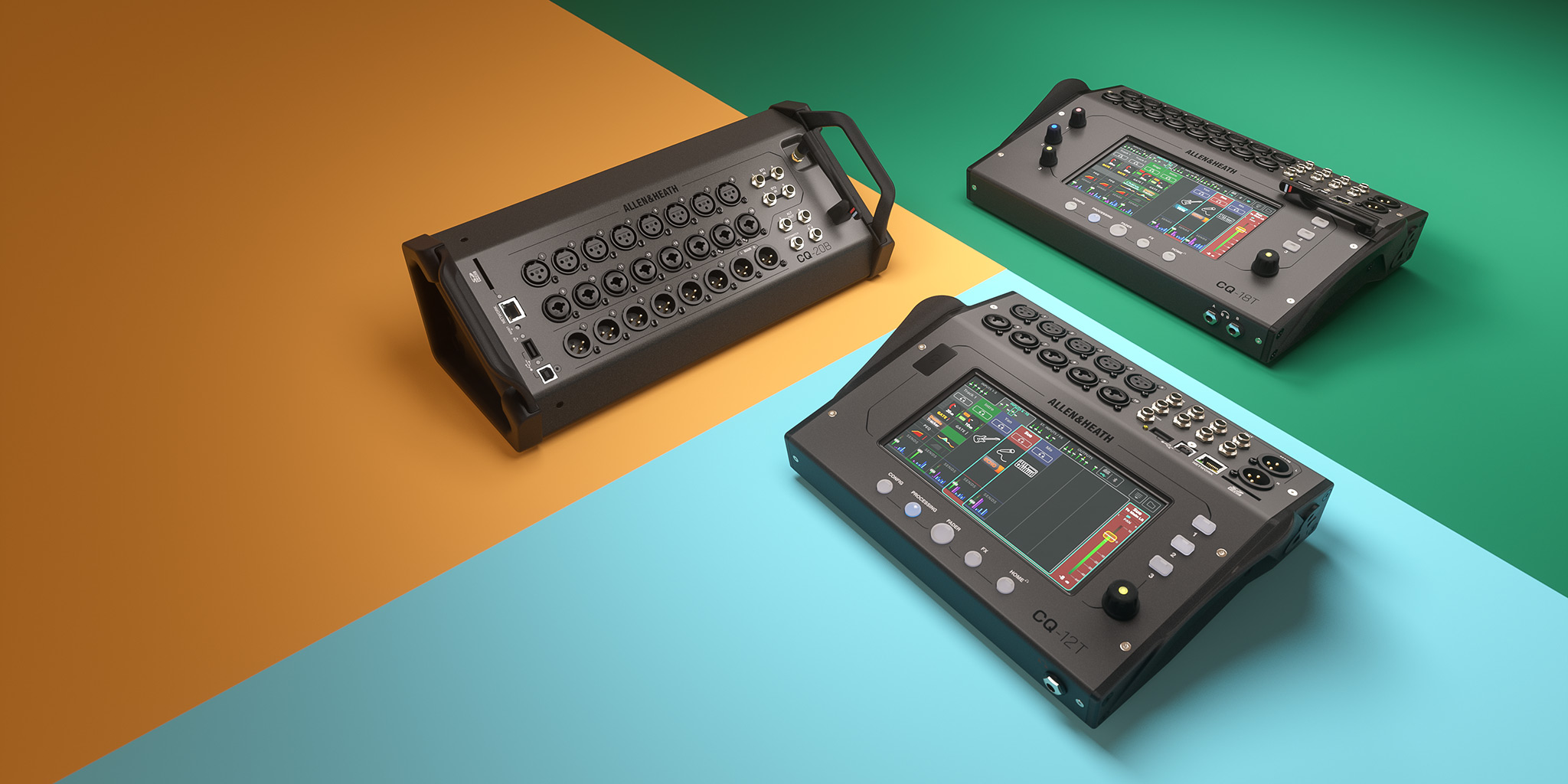
Allen & Heath CQ – See why this Mixer is leagues ahead of the pack
Allen & Heath have been on a bit of a warpath lately. And it has been waged on space. Just like the demand for living spaces is growing exponentially in both large and compact directions around the world, the digital mixer space is going through a similar spurt albeit leaning more towards the latter. The Award winning dLive CTi1500 and Avantis Solo are both great examples of the growth trend. In the case of the CTi1500 the entire housing was redesigned, the side trims are replaced with Titanium panels which are both lightweight and super-strong. The rear and base panels are still aircraft grade aluminum, but they have been shaved down to cut more weight. The internal bracing has also been further strengthened by using a metal alloy throughout, leading to a very trim 23kg gross weight even when loaded with an I/O card. This magic number means it can travel as a piece of checked in luggage.
S0 how, you may ask, does this lead to CQ? Well, it follows a path of developing compact digital mixers and doing it extremely well.
The three-model CQ range comprises of the CQ-12T and the CQ-18T with touch screens and the CQ-20B which is controlled soley by the free CQ MixPad App. Key to all of these models is the 96kHz FPGA processing engine. It is the same Field Gate system that is found in all the dLive and Avantis ranges and to dramatically simplify the technology, if I can use an electricity narrative, it is like running something in parallel. So, instead of building subsequent blocks which info has to pass through one by one, thereby slowing the data down, the field gate system works by passing data through a network of gates all at the same time which delivers phenomenal speeds and drops processing times to around 0.7ms! This amazing audio engine is partnered with a suite of studio-grade onboard effects tailored to the ultra-compact form factor.
Allen & Heath’s foray in the ultra-compact space is certainly turning heads. Not just for the beautiful form factor but also for the features that the A & H team have loaded into the chassis. So, in your bag of CQ tricks you have access to tool such as the Gain Assistant, which accurately sets an optimal gain level for you and continues to monitor the levels during a performance to track any surprises and deal with them. Another notch in the belt is an active Feedback Assistant which automatically detects and eliminates problem frequencies using up to 16 filters per output! The final weapon in the arsenal is the fantastic Auto Mic Mixing suite from the AHM series. This means you can instantly reduce background noise and improve clarity for speech applications all without having to lift a finger or fader. The AMM is available on all the input channels, so if you are thinking of podcasting or conferencing the CQ will make your life a lot easier with these tools on hand.
CQ packs a powerful USB interface into the entire range so you can playback and stream audio directly from your DAW but you can also Multi-Track record either directly to the DAW or onto an SD Card via the card slot. This is an incredible tool especially when you are offering postproduction products from recordings done in Live environments. Essentially, all of your audio is already gain structured and mixed before its even broken down into individual channels for you to edit down and master.
The 7” Touch screens on the CQ-12T and CQ-18T are both fantastic multi-touch screens that are super bright and when combined with the brilliant GUI that A & H have designed, it gives the range a very definitive, clean-cut look. Allen & Heath have also long held the reputation of being one of the easier desks to operate in the digital mixer space and its certainly continued with the CQ range. The entire user interface has been designed to accommodate both the uninitiated and those well versed in the pathways of audio engineering and there are two different modes to cater for these two distinct groups. Quick channels offer instrument and application specific processing with the power to dial in a full channel of processing on a single knob whilst Complete Channels lets you dive into advanced, in-depth tweaking of parameters and effects. All of the inputs have their own channels for control so you can easily coordinate and mix multiple sources whether they are being send via Bluetooth, USB, SD card, Stereo Sources, Instruments or Mics
App Pairings
The CQ range comes with a complete software package allowing for remote control of the Mix or even for Monitor control for Performers. The CQ MixPad is the full app which enables full remote control of the mixer via iOS, Android, Windows and MacOS devices allowing you to walk the room or stage and control the sound from the places where people will actually experience the audio. You can even connect two devices running MixPad together, each proving independent control. The CQ4You app is a free personal mixing app for the CQ series, that enables performers to control their own monitor mix from their Android or iOS devices, freeing the engineer to focus on the Front-of-House sound.
The Range
Inputs in the CQ-12 take the form of 10 mono mic/line inputs (5 x XLR and 5 x Combi) and 1 stereo input alongside the digital input formats of Bluetooth Audio, SD Card or USB. Outputs are XLR L and R for Main Output and then 6 x ¼” Jacks as additional outputs for In-Ear Monitors or to direct audio to monitors or other outputs like Subwoofers if you wanted specific low-end control beyond an EQ. The mixer also has 3 Custom Softkeys above the click-in rotary control that you can map to the functions you use most often. However, the limitations on the CQ-12T is that it will need to be connected to a router or access point to facilitate it connecting to the MixPad app and it has 2 FX assist slots available.
The larger CQ-18T hit the sweet spot for me in the range. It has 16 mic/line inputs (8 x XLR and 8 x Combo) on offer also with an additional Stereo input via Jack as well as the XLR L and R for Master Outputs and 6 x ¼” alternative outputs. The user interface on the 18T has 3 x Smart Rotaries and 3 x Custom Softkeys so it works out quicker to control things once you have spent the time to assign them for your most used functions. The CQ-18T also have 4 x FX Assist slots for a more powerful effects system. The CQ-18T has a powerful integrated dual-band Wi-Fi chip integrated into the body so you don’t need to bring a bulky access point or router along to use the apps with the 18T.
The CQ-20B has been designed to live its life on the stage and possesses the highest channel count of the CQ range. It also has a 16 x Mic/Line Input Count (8 x XLR and 8 x Combo) with 2 of those inputs as designated as HiZ inputs for Guitars with a further 2 x Stereo Inputs via Jack. Outputs are XLR L & R for main with 6 additional XLR outputs and an assignable Alt Out via Jack A and B. It also features an SD slot for recording or playback (24×24@48kHz or 16×16@96kHz), stereo USB record and playback, and Stereo Bluetooth playback. The CQ-20B also has built-in dual band 2.4/5G AC Wi-Fi so it can act as a router to connect the MixPad and CQ4U apps. The 20B also has Dual Footswitch connections for an additional floor level control for the mixer.
Limitations
There are some limitations to the CQ range, but these concerns are washed away as soon as you climb up the range to the QU, SQ, Avantis and dLive ranges. The CQ is a complete system on its own so it cannot expand the channel count by connecting to external stage boxes such as the AB, AR, DT, DX, or GX expanders. So, if you are looking to move up to higher channel counts and want to utilize Stage Boxes with FOH/Monitor setups with the proprietary dSNAKE network connection or, if your show or venue makes use of ACE, Dante, Waves or Klark technology then the bigger surfaces are your go to.
CQ- See Why
Spending some time with the CQ Ultra-Compacts has been an absolute pleasure. I steered away from the Quick Channel mode when working on the CQ’s because I do like to dive a little deeper and together with the Quick Rotaries and Quick Buttons, I had full control of the features without really having to use the marvelous touch screen. The sound engine was fantastic, as you would expect with an 96kHz engine. Effects were simple but very easy to use and they did improve the audio experience. Deep diving in the PEQ, Compressors, and Routing options was very easy to understand and execute the functions. The GUI was amazing! Bright, engaging and customizable are the words that come to mind, and that could be applied to the entire experience working with CQ. This is the perfect mixer for those catering for smaller shows and conferences or those that have resisted and are finally delving into the world of digital and want a nice gentle splash. The CQ-18T is the one that grabbed me the most, but I can certainly see the appeal of the CQ-20B with an iPad for stage shows.




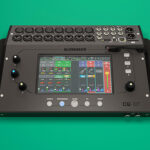


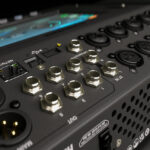
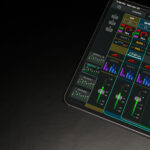
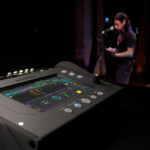

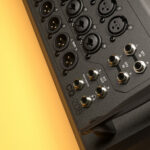
No Comments